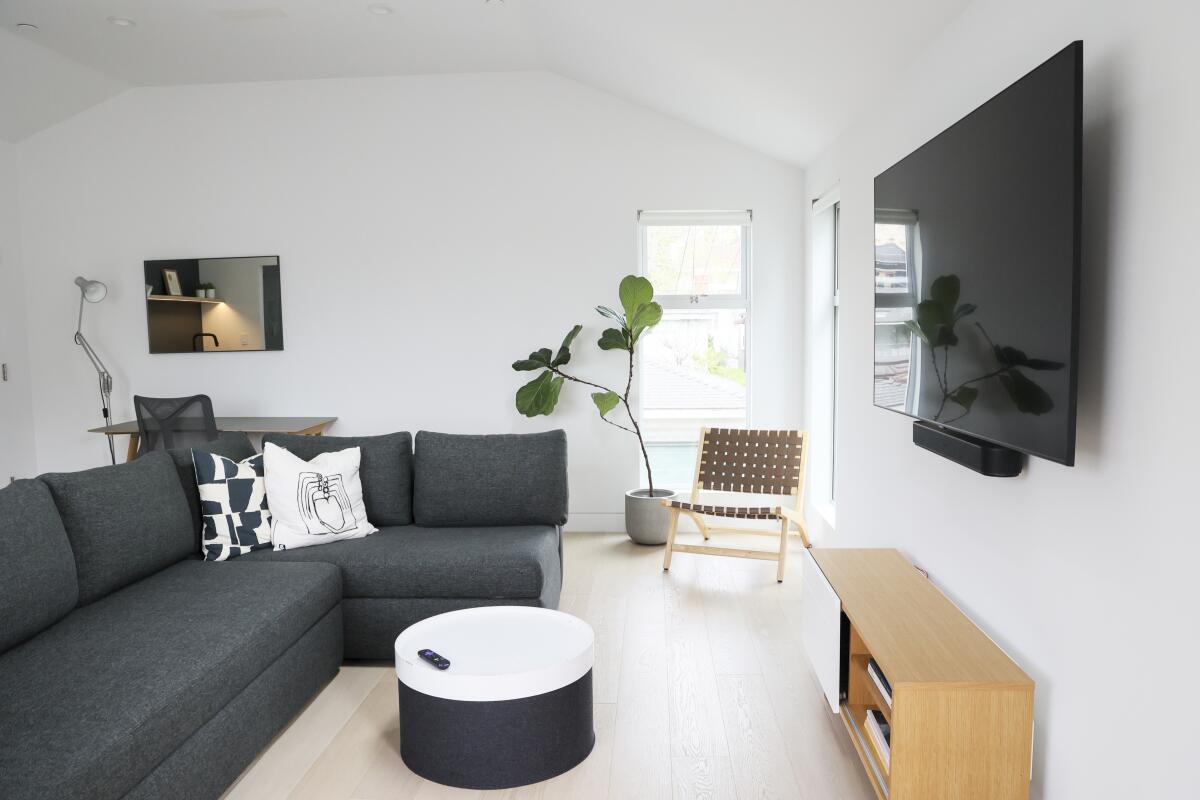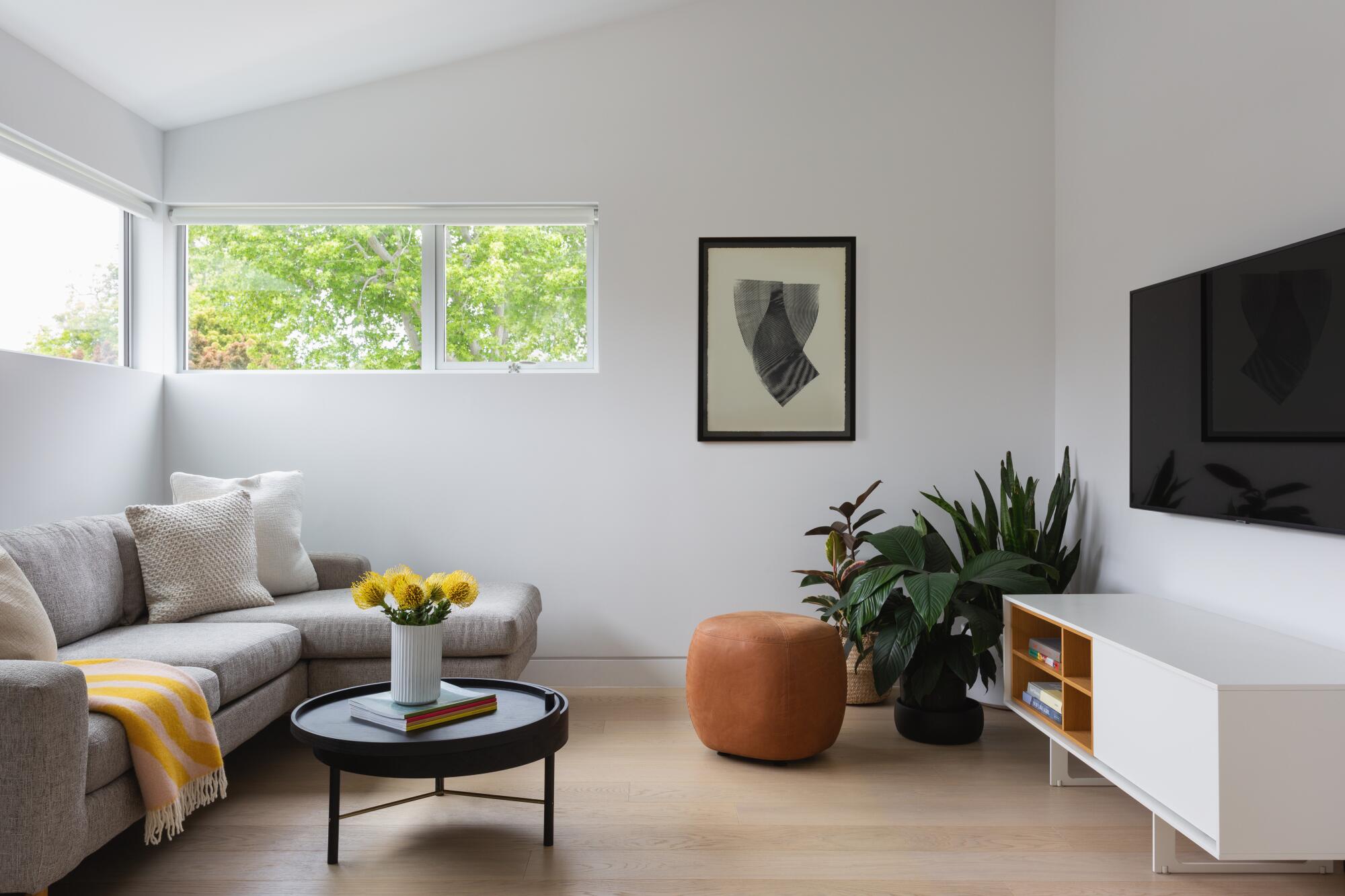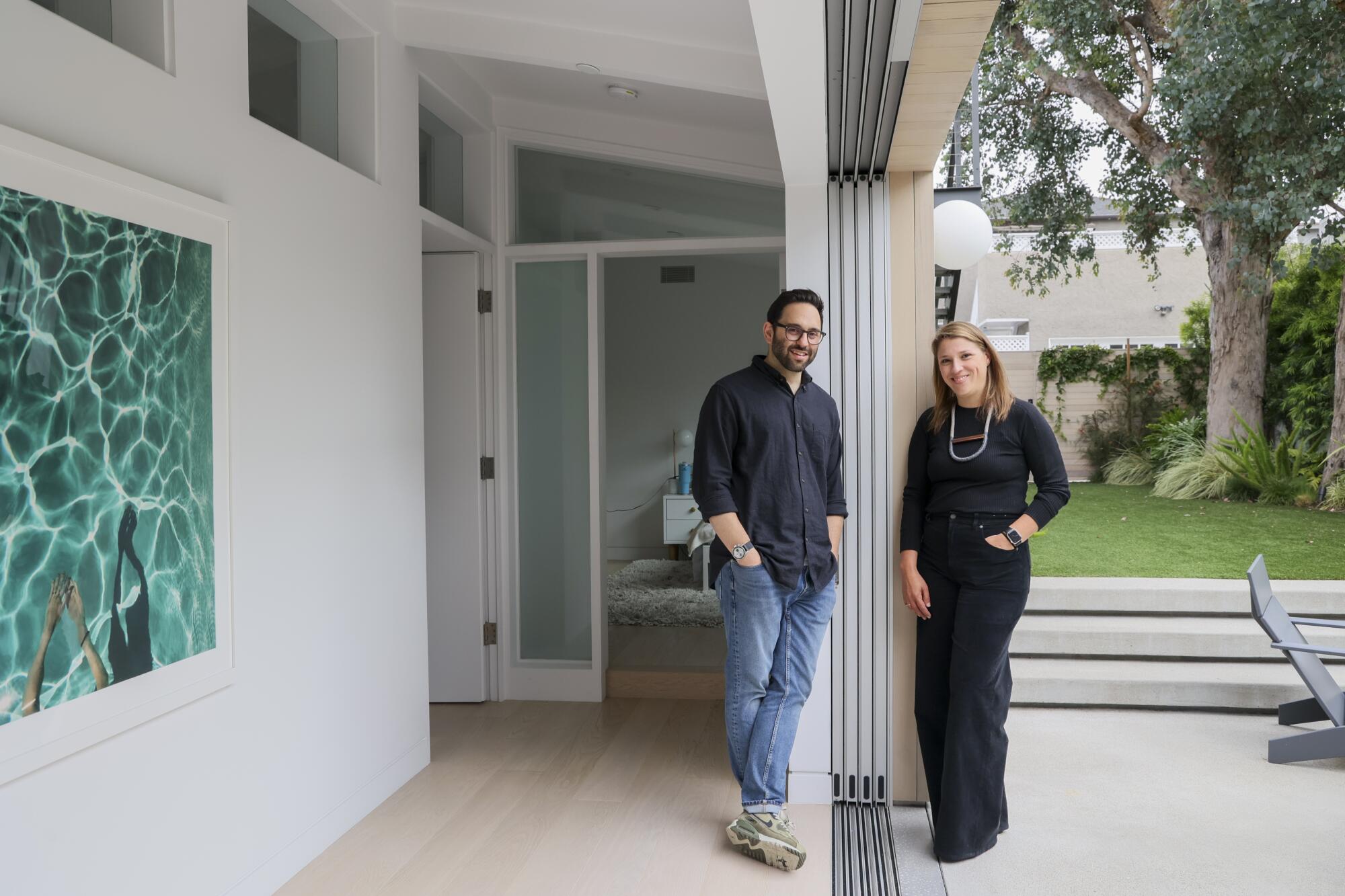If ever there were a home that told the story of the emotional attachment we have to our neighborhoods in Los Angeles, this is it.
Not because of the sweet bungalow, which is situated in a dense Manhattan Beach neighborhood where parking is scarce and neighbors are often on top of one another. Or the calm light-filled interiors. Or even the modern ADU above the garage that nicely complements the main house.
Paul and Cailin Goncalves’ home stands out for its relationship to the outdoors, symbolizing their love for the Pacific Ocean just blocks away.
“My son and I surf regularly down the street,’” says Paul, who is an entrepreneur. “The beach is our backyard.”
“We love our neighborhood,” adds Cailin, an executive at Condé Nast. “It’s alive with kids everywhere.”Additionally, the home had outdoor space, something the couple thought they wouldn’t get close to the beach.
Architects Harper Halprin and Aaron Leshtz wrapped the house in durable western red cedar to give it the look of a modern surf shack.
(Amy Bartlam / For The Times)

The Manhattan Beach home before it was remodeled.
(AAHA Studio)
When the couple purchased the 1949 Craftsman-style home in 2013, the home’s location on a street-to-alley lot was another plus. But after more than a decade in the three-bedroom house with their two children, now 12 and 17, they wanted to break free of their compartmentalized interiors.
Like many homeowners in Los Angeles, one of the most unaffordable cities for homebuyers, the couple faced a dilemma. They wanted something more contemporary without sacrificing their neighborhood for a new home. They also didn’t want to add a second floor, which is common in Manhattan Beach, where they would find themselves looking into their neighbors’ living spaces and not at the ocean. Similarly, the loss of the backyard was nonnegotiable as the family enjoyed spending time outdoors.
“We definitely looked around prior to embarking on the renovation to see what was out there,” says Cailin, 49. “But the more we looked, we realized we would never secure exactly what we wanted unless we did it ourselves. We really felt like our location was the perfect spot.”
Architects Harper Halprin and Aaron Leshtz of AAHA Studio proposed a solution. They suggested rethinking the home’s awkward layout in favor of something open that maximizes natural light, allowing the family to stay in their beloved neighborhood without adding on to the 1,744-square foot floorplan.




Before the ADU was redone, left, the family rarely used it. (AAHA Studio) Today, right, both the ADU and yard serve as popular gathering places for the family and their friends. (Juliana Yamada/Los Angeles Times)
“Paul and Cailin are creative people, “ Leshtz explains. “They wanted to make the most of what they had by reshaping it in their image. For us, it was about enhancing the spaces and creating clever ways to open up the interior, so it flowed better and felt connected to their backyard.”
“You have to be careful about what you add when you are creating a minimalist interior,” Halprin notes.
Inspired by the simplicity of Scandinavian design, with its focus on natural materials and light, the couple wanted their living spaces to be streamlined and flush, which the architects achieved by using uniform light wood tones throughout the house. On the outside, the architects removed the gravel roof and added a standing-seam metal roof to achieve a more contemporary look, wrapping the house in durable western red cedar from Delta Millworks to give it the clean-lined look of a modern surf shack.

Sliding Fleetwood pocket doors open the airy kitchen and living spaces to the backyard.
(Juliana Yamada/Los Angeles Times)
Because there was a fundamental disconnect between the living room and the entrance to the house, the architects moved the front door, which previously opened on to a side room, to the center. They also widened the circulation zone between the living room and kitchen, which opened up the interiors further.
To give the kids privacy, they added large pocket doors to the study, allowing them to close the door while watching television or socializing with friends.
The bathrooms were gutted, reorganized and made more functional with careful attention to natural light, in keeping with the clean aesthetic of the house.
The newly renovated kitchen is outfitted with custom cabinets in light wood that open onto a south-facing courtyard courtesy of a Fleetwood pocket door system that replaced a series of French doors. The process, however, turned out to be more extensive than they had expected. “It was more down to the studs than anticipated,” says Leshtz. “I showed up one day and found the roof was off because the house was falling apart.”
Ultimately, the architects reframed the kitchen and added vaulted ceilings and skylights, which make the interiors feel much larger than they are.
“The new pocket door makes the kitchen feel like you’re outside,” adds Paul, 52.

The ADU studio above the garage before it was updated. (AAHA Studio )

And after. (Juliana Yamada/Los Angeles Times)

A black matte kitchenette in the ADU makes a dramatic statement.
(Juliana Yamada / Los Angeles Times)
With little extra space in the three-bedroom house, the couple sought to expand their footprint by updating the existing accessory dwelling unit above the garage to create a more versatile space.
“It was underutilized, and it felt like it had nothing to do with the main house,” Leshtz says. “Our goal was to make the access feel like it connected to the yard. That’s why we installed a steel staircase, which gives the space so much flexibility. It was a rickety wooden stairway before. We wanted it to be an obvious form in the back because it’s looming so much over the yard.”
According to Paul, whose family from Portugal often resides in the ADU, the couple wanted the 400-square-foot studio to “feel like a hotel.”

Cantilevered windows in the living room of the main house bring in light and provide privacy from the street.
(Amy Bartlam / For The Times)
“My parents have stayed in it for a month,” he says. “Cailin’s parents stay in it when they visit from Philadelphia. We never used it before the renovation, but now we work in the ADU, and the kids love to hang out there,” including their son, who enjoys practicing his DJ skills without disturbing anyone.
Looking ahead, they also have the option of renting out the ADU, which can be entered privately through the alley behind the house.


The original bathroom in the ADU before it was redone. (AAHA Studio) And after. (Amy Bartlam/ For The Times )
The studio features a sleeper sofa and a sleek kitchenette with Fenix black matte laminate cabinets and a backsplash, along with matte black fixtures that add drama and a nice contrast to the white walls.
Like the main house, the couple wanted the ADU to be simple, so the architects carefully installed the windows to capture the light and allow for privacy. These design elements, along with the thoughtful layout, make the ADU a versatile space that can serve as a guest suite, a home office, or a place for the kids to hang out.


The Goncalves family uses the outdoor shower after hitting the beach down the street. (Amy Bartlam / For The Times )

A view of the ADU from the alley.
(Amy Bartlam / For The Times )
The home and the ADU are connected by a new courtyard, which was formerly composed of red brick and is now lined with smooth concrete. The outdoor space includes a welcoming firepit, dining and seating area that feels like an extension of the house.
It also includes an outdoor shower. “We use it all the time,” Paul says, standing in a garage filled with surfboards and bikes.
Despite the project taking two years to complete, the couple, who rented a house in the neighborhood during construction, say it was well worth the wait. (They declined to share their budget.)
“I grew up surfing in Montauk, and I wanted to create that feeling here,” Paul says before adding, “It’s heaven.”

Architects Aaron Leshtz and Harper Halprin of AAHA Studio.
(Juliana Yamada / Los Angeles Times)
